Sustainable Utilization of Stabilized Dredged Material for Coastal Infrastructure: Innovations in Non-Fired Brick Production and Erosion Control
Abstract
1. Introduction
2. Dredging Location
3. Materials and Methods
3.1. Mixes
3.2. Proposed Mix Designs and Laboratory Tests
4. Results and Discussion
4.1. Particle Size Distribution
4.2. Untreated Dredged Material
4.3. Stabilized Dredged Material
4.3.1. Compaction Behavior
4.3.2. Compressive Strength
4.4. Scanning Electron Microscopy (SEM)
5. Conclusions
Author Contributions
Funding
Institutional Review Board Statement
Data Availability Statement
Conflicts of Interest
References
- Nguyen, T.T.M.; Rabbanifar, S.; Brake, N.A.; Qian, Q.; Kibodeaux, K.; Crochet, H.E.; Oruji, S.; Whitt, R.; Farrow, J.; Belaire, B.; et al. Stabilization of Silty Clayey Dredged Material. J. Mater. Civ. Eng. 2018, 30, 04018199. [Google Scholar] [CrossRef]
- Berkowitz, J.F.; Green, L.; VanZomeren, C.M.; White, J.R. Evaluating Soil Properties and Potential Nitrate Removal in Wetlands Created Using an Engineering with Nature Based Dredged Material Placement Technique. Ecol. Eng. 2016, 97, 381–388. [Google Scholar] [CrossRef]
- Grubb, D.G.; Chrysochoou, M.; Smith, C.J.; Malasavage, N.E. Stabilized Dredged Material. I: Parametric Study. J. Geotech. Geoenvironmental Eng. 2010, 136, 1011–1024. [Google Scholar] [CrossRef]
- Bolam, S.G.; Rees, H.L. Minimizing Impacts of Maintenance Dredged Material Disposal in the Coastal Environment: A Habitat Approach. Environ. Manag. 2003, 32, 171–188. [Google Scholar] [CrossRef] [PubMed]
- Millrath, K.; Kozlova, S.; Shimanovich, S. Beneficial Use of Dredged Material 2; Columbia University: New York, NY, USA, 2001. [Google Scholar]
- Wang, M.; Hull, J.; Jao, M. Stabilization of Water Treatment Plant Sludge for Possible Use as Embankment Material. In Transportation Research Record; Transportation Research Board: Washington, DC, USA, 1992; p. 1345. [Google Scholar]
- Bell, F.G. Lime Stabilization of Clay Minerals and Soils. Eng. Geol. 1996, 42, 223–237. [Google Scholar] [CrossRef]
- Nalbantoglu, Z.; Tuncer, E.R. Compressibility and Hydraulic Conductivity of a Chemically Treated Expansive Clay. Can. Geotech. J. 2001, 38, 154–160. [Google Scholar] [CrossRef]
- Ghosh, A.; Subbarao, C. Tensile Strength Bearing Ratio and Slake Durability of Class F Fly Ash Stabilized with Lime and Gypsum. J. Mater. Civ. Eng. 2006, 18, 18–27. [Google Scholar] [CrossRef]
- Poh, H.Y.; Ghataora, G.S.; Ghazireh, N. Soil Stabilization Using Basic Oxygen Steel Slag Fines. J. Mater. Civ. Eng. 2006, 18, 229–240. [Google Scholar] [CrossRef]
- Sariosseiri, F.; Muhunthan, B. Effect of Cement Treatment on Geotechnical Properties of Some Washington State Soils. Eng. Geol. 2009, 104, 119–125. [Google Scholar] [CrossRef]
- Horpibulsuk, S.; Phojan, W.; Suddeepong, A.; Chinkulkijniwat, A.; Liu, M.D. Strength Development in Blended Cement Admixed Saline Clay. Appl. Clay Sci. 2012, 55, 44–52. [Google Scholar] [CrossRef]
- Shen, S.; Wang, Z.; Horpibulsuk, S.; Kim, Y.H. Jet Grouting with a Newly Developed Technology: The Twin-Jet Method. Eng. Geol. 2013, 152, 87–95. [Google Scholar] [CrossRef]
- Shen, S.-L.; Wang, Z.-F.; Sun, W.-J.; Wang, L.-B.; Horpibulsuk, S. A Field Trial of Horizontal Jet Grouting Using the Composite-Pipe Method in the Soft Deposits of Shanghai. Tunn. Undergr. Space Technol. 2013, 35, 142–151. [Google Scholar] [CrossRef]
- Shen, S.; Hou, D.; Zhao, J.; Horpibulsuk, S. Assessment of Internal Forces for Intermediate Anchorage Zone of Post-Tensioned Concrete Structure. Constr. Build. Mater. 2014, 64, 370–378. [Google Scholar] [CrossRef]
- Shen, S.; Wu, H.; Cui, Y.; Yin, Z.Y. Long-Term Settlement Behaviour of Metro Tunnels in the Soft Deposits of Shanghai. Tunn. Undergr. Space Technol. 2014, 40, 309–323. [Google Scholar] [CrossRef]
- Barciela-Rial, M.; Vardon, P.J.; Van Kessel, T.; Griffioen, J.; Winterwerp, J.C. Effect of Composition on the Compressibility and Shear Strength of Dredged Cohesive Sediment. Front. Earth Sci. 2022, 10, 786108. [Google Scholar] [CrossRef]
- Yu, C.; Cui, C.; Zhao, J.; Liu, F.; Fu, S.; Li, G. Enhancing mechanical properties of dredged sludge through carbonation stabilization employing steel slag: An eco-friendly and cost-effective approach. Constr. Build. Mater. 2024, 412, 134748. [Google Scholar] [CrossRef]
- Athira, S.; Subaida, E.A.; Vinod, P. A framework for geotechnical characterization of dredged reservoir sediments and its sustainable reuse after stabilization. Environ. Earth Sci. 2024, 83, 152. [Google Scholar] [CrossRef]
- Showkat, R.; Mir, B.A.; Wani, K.M.N.S. Experimental investigation on reuse of dredged soils improved using waste rubber tyre powder (WRTP) and cement as admixtures. Geomech. Geoengin. 2024, 1–15. [Google Scholar] [CrossRef]
- Kishore, M.S.; Gayathri, S.; Varma, D.A.; Tharayil, J.M. Revitalizing dredged soils through chemical-physical combined method: A feasibility study. Mar. Georesources Geotechnol. 2023, 1–16. [Google Scholar] [CrossRef]
- Nguyen, T.T.M.; Rabbanifar, S.; Luo, Z.; Huddleston, C.; O’Connor, T.; Richard, A.; Michel, M.; Moon, R.; Yao, C.W.; Jao, M.; et al. Development of Fiber Reinforced Sustainable Dredge Bricks. Appl. Sci. 2023, 13, 789. [Google Scholar] [CrossRef]
- Rabbanifar, S.; Nguyen, T.T.M.; Yao, C.W.; Qian, Q.; Bernazzani, P.; Jao, M. Adding Value to Dredged Material Using Lime and Ash Products. In Proceedings of the Recent Trends in Geotechnical Geo-Environmental Engineering and Education, RTG2EE International Conference, Online, Brisbane, Australia, 10–11 September 2020; pp. 94–98, ISBN-13: 978-0-6489449-0-4. [Google Scholar]
- Sadat Associates Inc. Use of Dredged Materials for the Construction of Roadway Embankments; OENJ Corporations Inc.: Princeton, NJ, USA, 2001. [Google Scholar]
- Milburn, J.; Parsons, R. Performance of Soil Stabilization Agents; Kansas Department of Transportation: Topeka, KS, USA, 2004. [Google Scholar]
- Riza, F.; Rahman, I.; Zaidi, A.M.A. Brief Review of Compressed Stabilized Earth Brick (CSEB). In Proceedings of the International Conference on Science and Social Research, Dubrovnik, Croatia, 5–7 December 2010; pp. 999–1004. [Google Scholar]
- Mackiewicz, S.; Ferguson, E.G. Stabilization of Soil with Self-Cementing Coal Ashes. In Proceedings of the 2005 World of Coal Ash (WOCA), Lexington, KC, USA, 11–15 April 2005; pp. 1–7. [Google Scholar]
- Kumar, S. A Perspective Study on Fly Ash–Lime–Gypsum Bricks and Hollow Blocks for Low Cost Housing Development. Constr. Build. Mater. 2002, 16, 519–525. [Google Scholar] [CrossRef]
- Cicek, T.; Tanrıverdi, M. Lime Based Steam Autoclaved Fly Ash Bricks. Constr. Build. Mater. 2007, 21, 1295–1300. [Google Scholar] [CrossRef]
- Turgut, P. Manufacturing of Building Bricks without Portland Cement. J. Clean Prod. 2012, 37, 361–367. [Google Scholar] [CrossRef]
- Vinai, R.; Lawane, A.; Minane, J.; Amadou, A. Coal Combustion Residues Valorisation: Research and Development on Compressed Brick Production. Constr. Build. Mater. 2013, 40, 1088–1096. [Google Scholar] [CrossRef]
- Hydraform. Hydraform Technical Specifications of Hydraform Bricks; Hydraform: Johannesburg, South Africa, 2017. [Google Scholar]
- Sitton, J.D.; Zeinali, Y.; Heidarian, W.H.; Story, B.A. Effect of Mix Design on Compressed Earth Block Strength. Constr. Build. Mater. 2018, 158, 124–131. [Google Scholar] [CrossRef]
- New Mexico Earthen Building Materials Code. Construction Industries Division of the Regulation and Licensing Department. Title 14: Housing and Construction Chapter 7: Building Codes General. 2009. Available online: http://www.udcinc.org/2009%20New%20Mexico%20Earthen%20Building%20Materials%20Code.pdf (accessed on 9 January 2024).
- International Building Code 2003. Chapter 21: Masonry. Available online: https://codes.iccsafe.org/content/IBC2003/cover (accessed on 9 January 2024).
- Rabbanifar, S.; Nguyen, T.T.M.; Qian, Q.; Brake, N.A.; Kibodeaux, K.; Crochet, H.E.; Oruji, S.; Whitt, R.L.; Farrow, J.S.; Belaire, B.G.; et al. Reusing Dredged Material through Stabilization with So-Called Bio-Enzyme Products. Buildings 2023, 13, 2618. [Google Scholar] [CrossRef]
- ASTM International. Available online: https://www.astm.org/ (accessed on 9 January 2024).
- Federico, A.; Vitone, C.; Murianni, A. On the Mechanical Behaviour of Dredged Submarine Clayey Sediments Stabilized with Lime or Cement. Can. Geotech. J. 2015, 52, 2030–2040. [Google Scholar] [CrossRef]
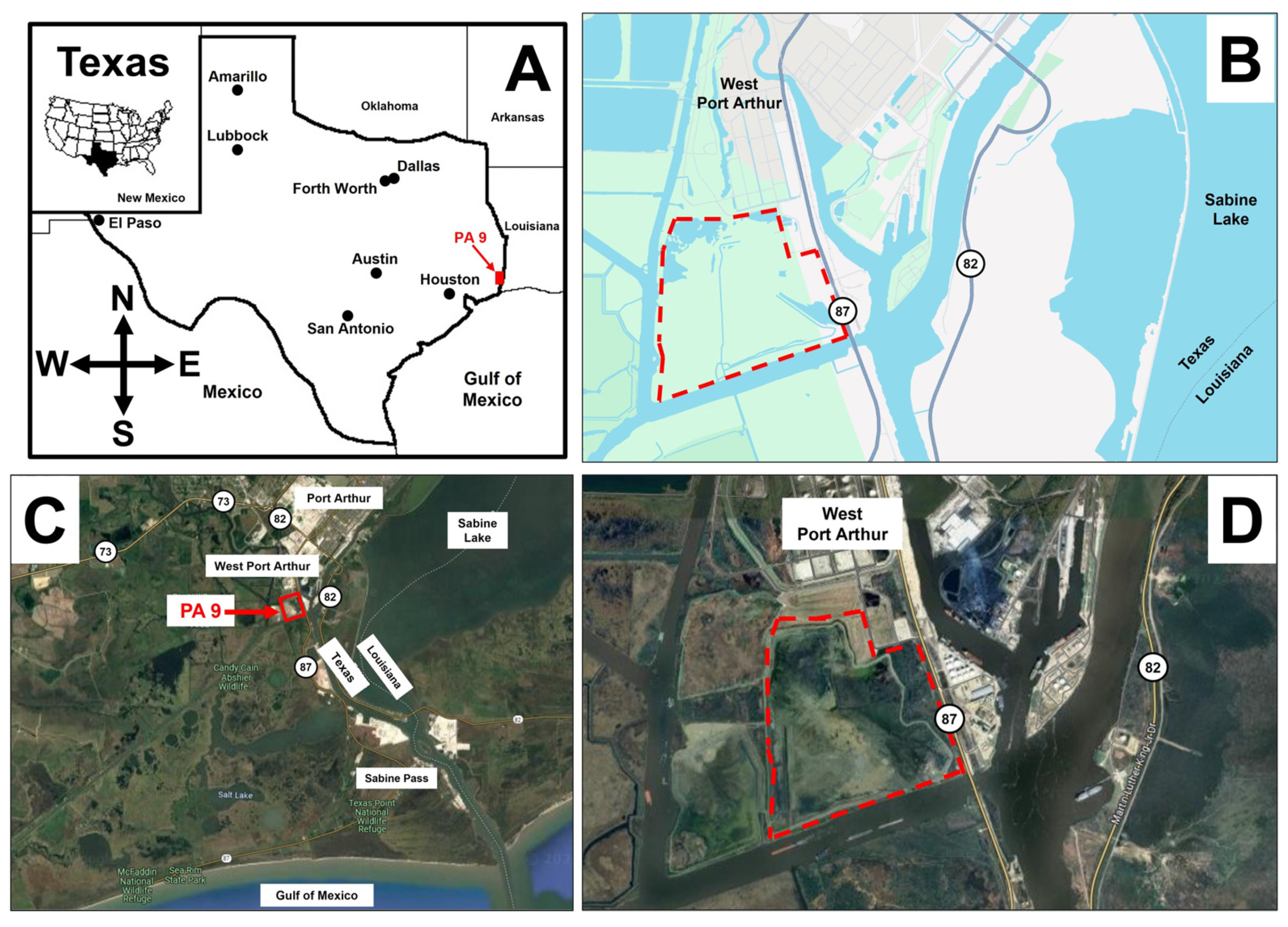


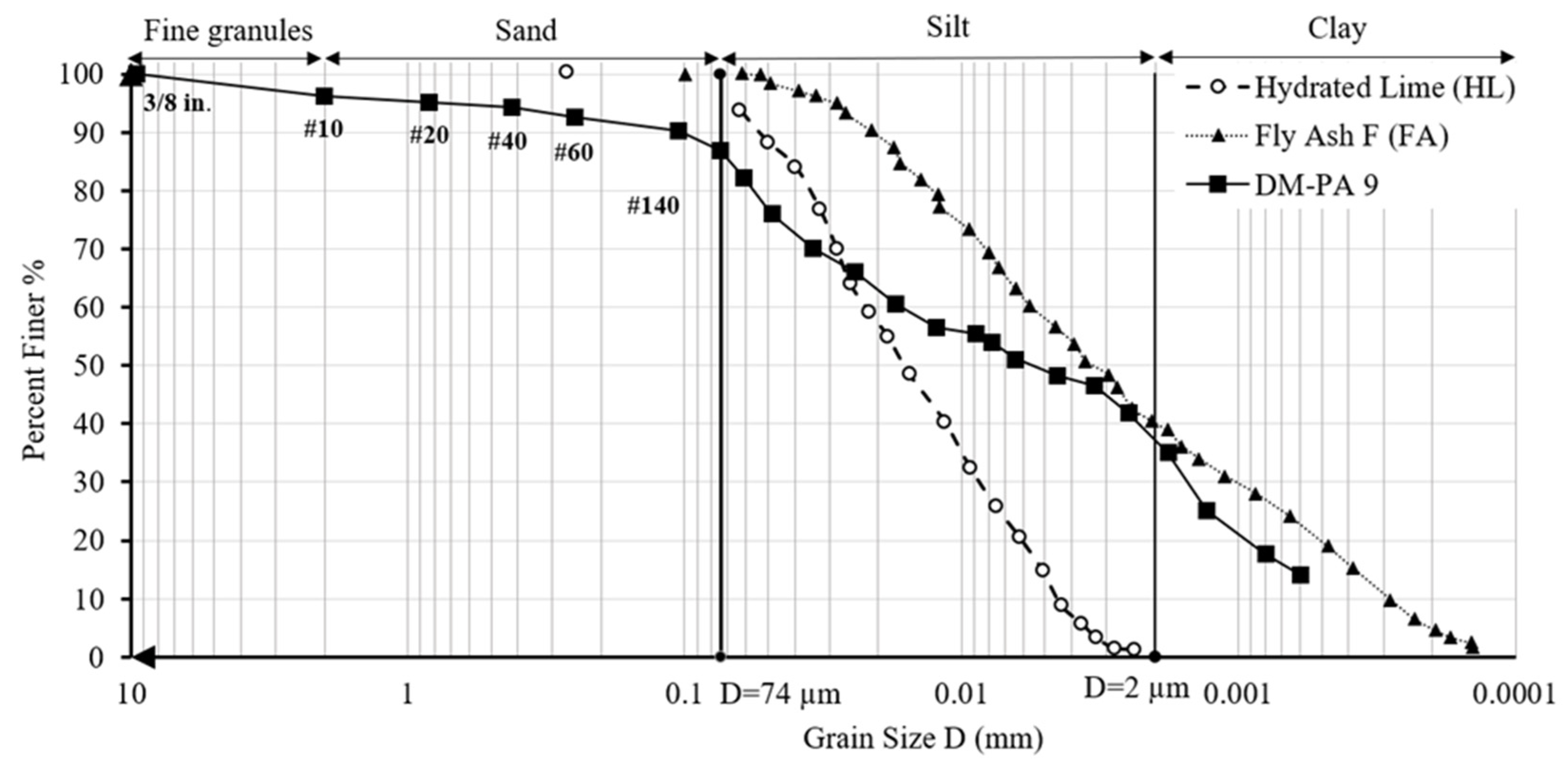
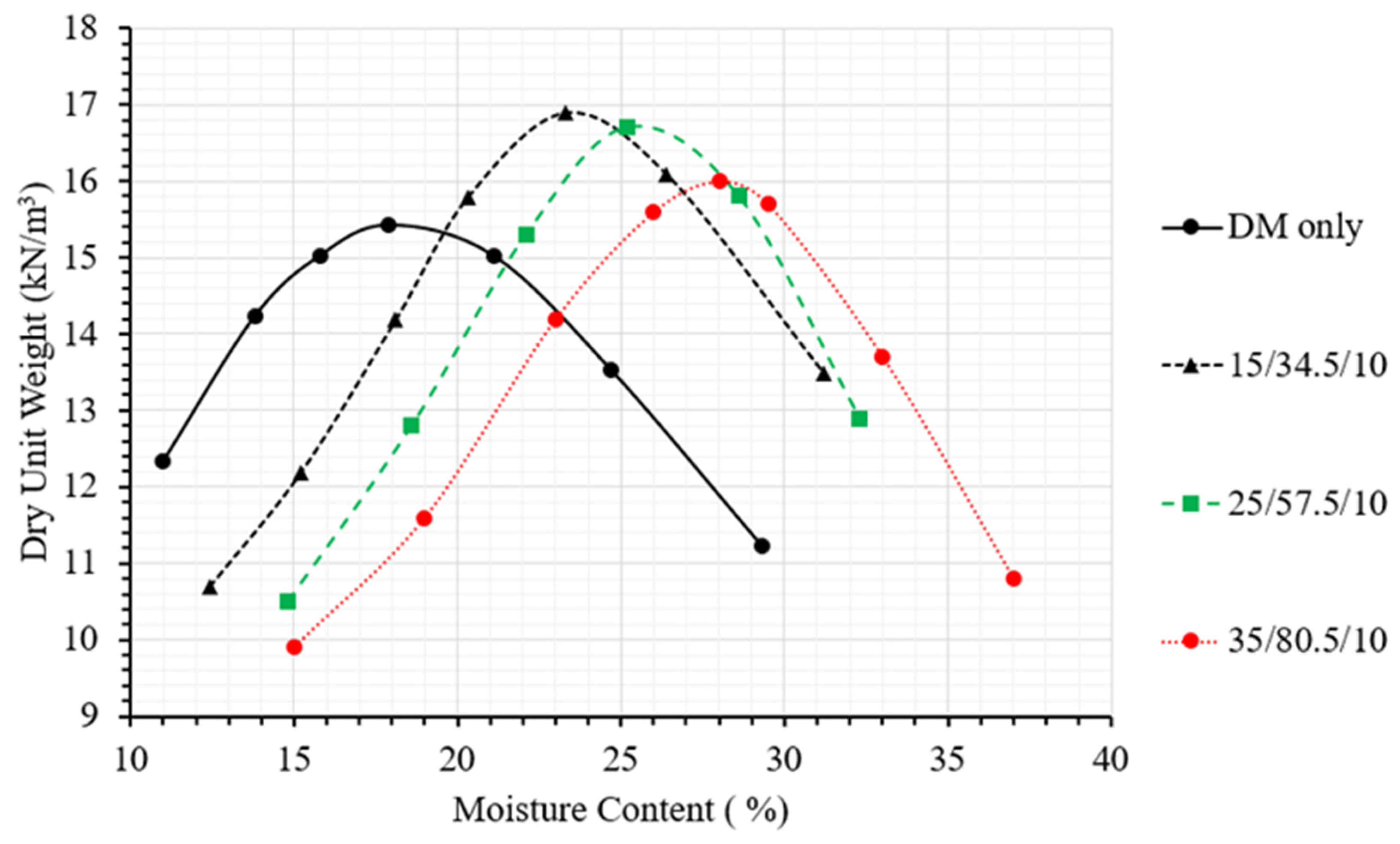
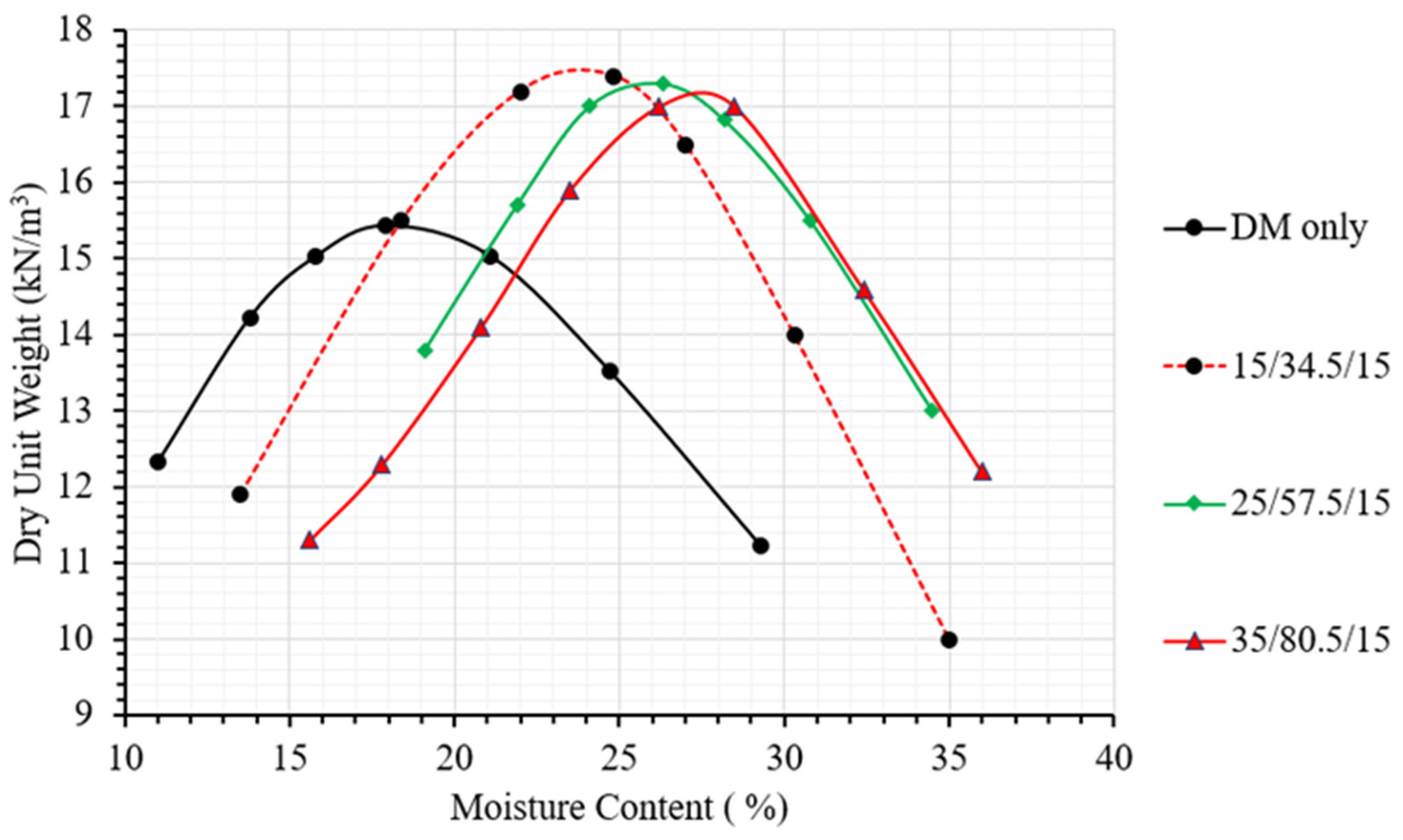
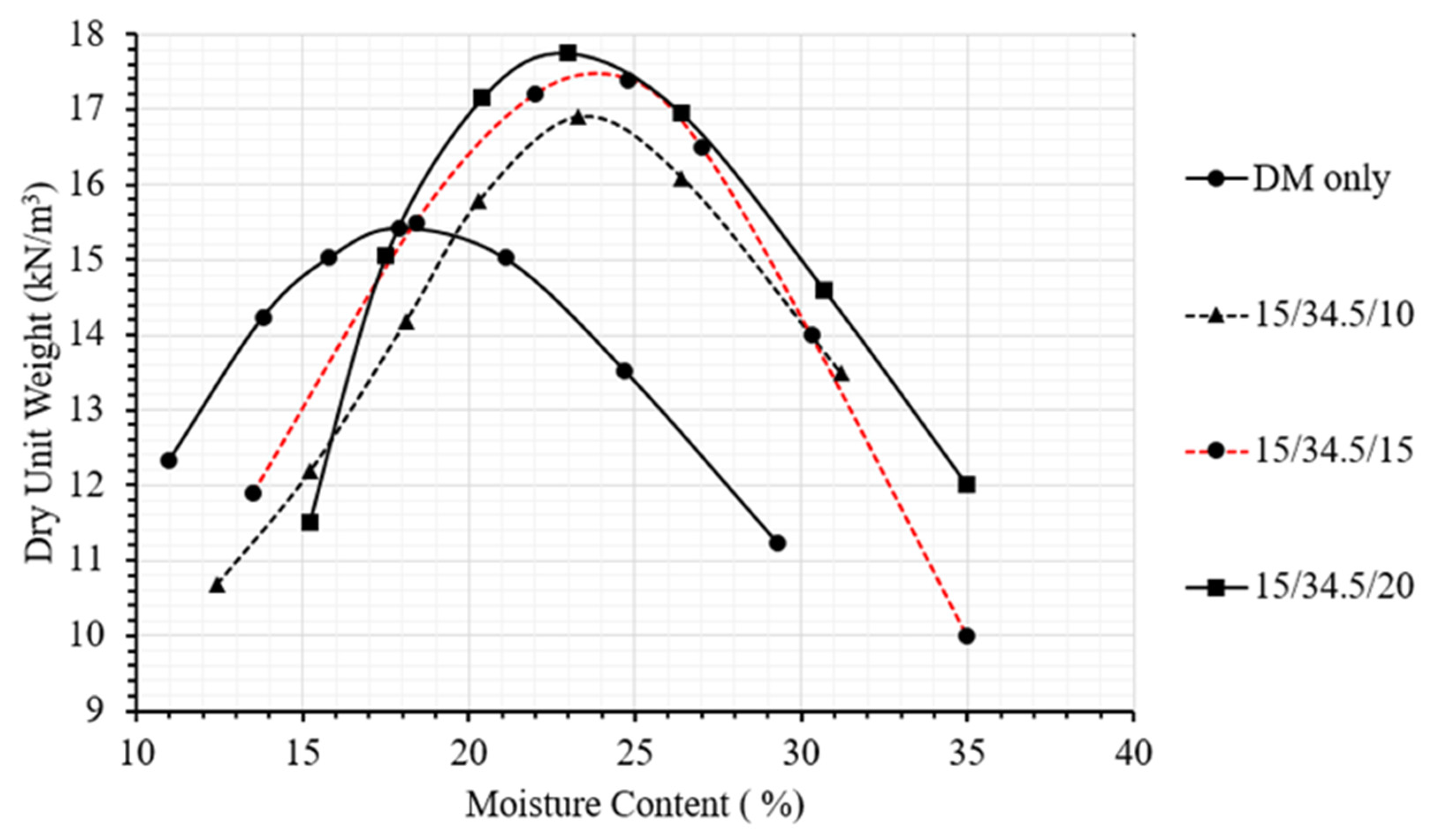
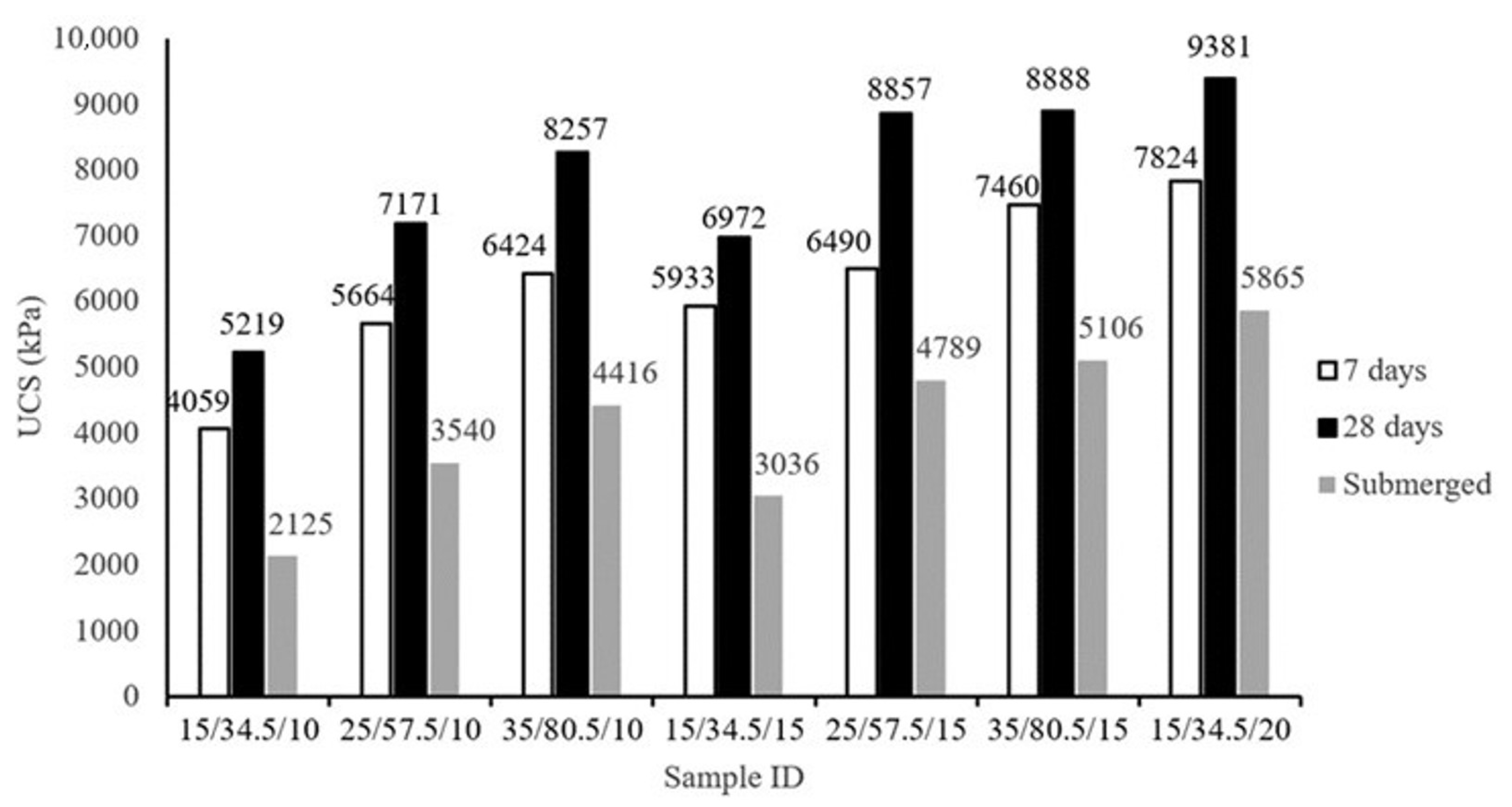
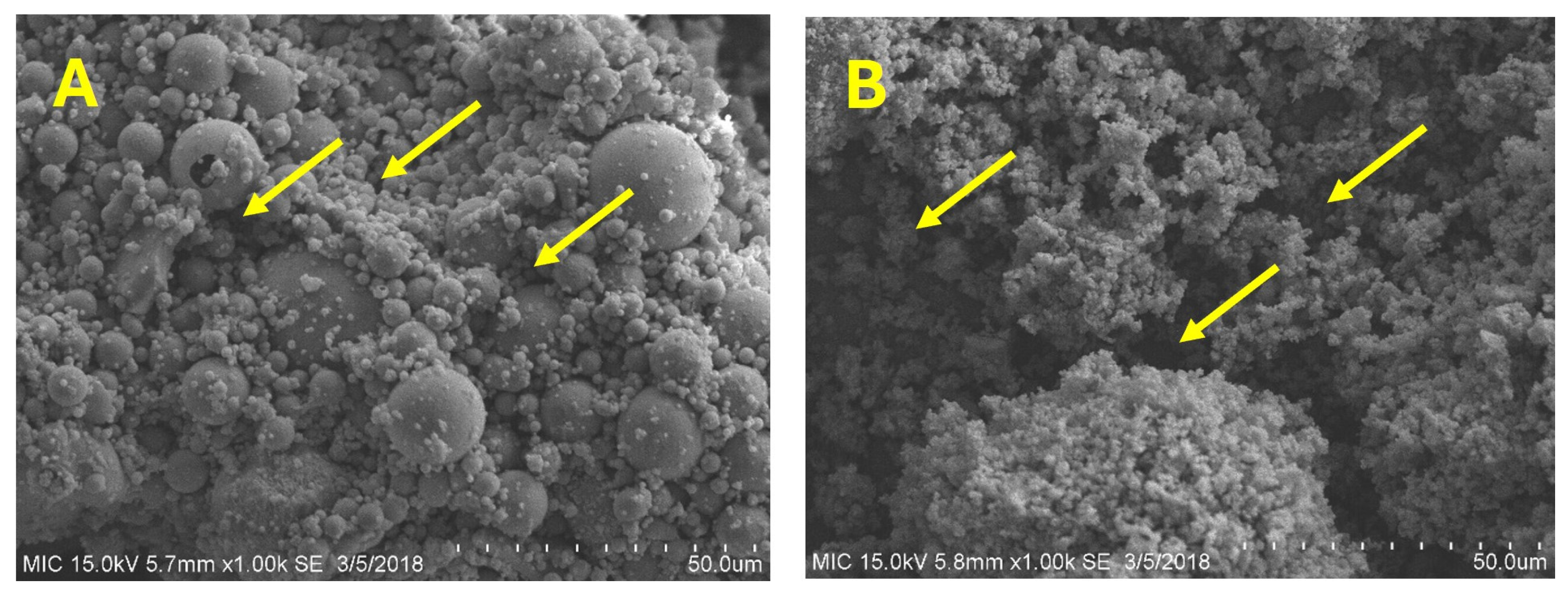
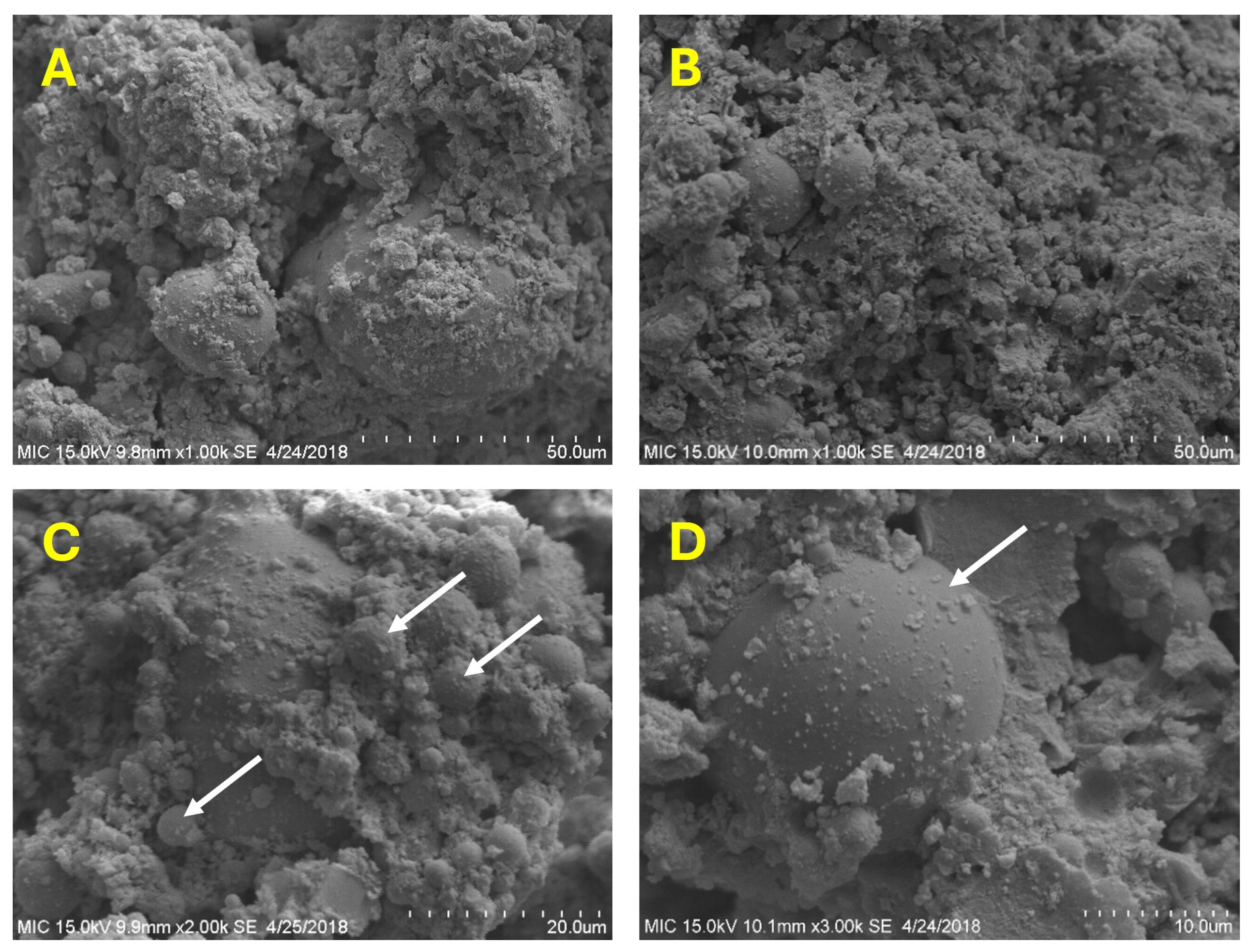
| Chemical Analysis (wt.%) | FA | HL | PC |
|---|---|---|---|
| CaO (% as Ca(OH)2) | 14.5 | >85 | 62.88 |
| Silicon Dioxide (SiO2) | 52.24 | <0.1 | 20.61 |
| Aluminum Oxide (Al2O3) | 18.61 | 0.24 | 4.4 |
| Iron Oxide (Fe2O3) | 4.82 | 0.49 | 3.32 |
| Magnesium Oxide (MgO) | 3.85 | 0.22 | 2.20 |
| Sulfur Trioxide (SO3) | 0.78 | 0.87 | 2.7 |
| Sodium Oxide (Na2O) | 1.00 | - | 0.19 |
| Potassium Oxide (K2O) | 1.28 | - | 0.50 |
| Loss on ignition (LoI) | 0.35 | 24.00 | 1.29 |
| Specific Gravity | 2.50–2.80 | 2.20–2.40 | 3.15 |
| pH (at 25 °C) | 7–12 | 12.45 |
| Mix No. | HL | FA | PC | % Cementitious (pwd) | % DM (pwd) |
|---|---|---|---|---|---|
| 1 | 0.0 | 0.0 | 0 | 0.0 | 100.0 |
| 2 | 15.0 | 34.5 | 10 | 37.3 | 62.7 |
| 3 | 25.0 | 57.5 | 10 | 48.1 | 52.0 |
| 4 | 35.0 | 80.5 | 10 | 55.7 | 44.4 |
| 5 | 15.0 | 34.5 | 15 | 39.2 | 60.8 |
| 6 | 25.0 | 57.5 | 15 | 49.4 | 50.6 |
| 7 | 35.0 | 80.5 | 15 | 56.6 | 43.4 |
| 8 | 15.0 | 34.5 | 20 | 41.0 | 59.0 |
| Tests Conducted | Property Description | Value |
|---|---|---|
| Particle Size | % Passing No. 200 | 86.9 |
| % Sand | 9.4 | |
| % Gravel | 3.7 | |
| Unconfined Compressive Strength (kPa) | 283 (41 psi) | |
| Dry Unit Weight (kN/m3) | 15.9 | |
| Moisture Content (%) | 68–82% | |
| Specific Gravity | 2.69 | |
| Organic Content | 12–18% | |
| Proctor | γd,max (lb/ft3) | 101 |
| ωopt (%) | 21 | |
| Atterberg Limits (%) | Liquid Limit | 52 |
| Plastic Limit | 24 | |
| Plasticity Index | 28 | |
| Classification (USCS) | OH—Organic clay of medium to high plasticity organic silt | |
| SN | ID (HL/FA/PC) | Ave CS7 (kPa) | Ave CS28 (kPa) | Ave Submerged CS (kPa) | Remaining CS (Submerged/28) |
|---|---|---|---|---|---|
| 1 | 15/34.5/10 | 4059 | 5219 | 2125 | 41 |
| 2 | 25/57.5/10 | 5664 | 7171 | 3540 | 49 |
| 3 | 35/80.5/10 | 6424 | 8257 | 4416 | 53 |
| 4 | 15/34.5/15 | 5933 | 6972 | 3036 | 44 |
| 5 | 25/57.5/15 | 6490 | 8857 | 4789 | 54 |
| 6 | 35/80.5/15 | 7460 | 8888 | 5106 | 57 |
| 7 | 15/34.5/20 | 7824 | 9381 | 5865 | 63 |
Disclaimer/Publisher’s Note: The statements, opinions and data contained in all publications are solely those of the individual author(s) and contributor(s) and not of MDPI and/or the editor(s). MDPI and/or the editor(s) disclaim responsibility for any injury to people or property resulting from any ideas, methods, instructions or products referred to in the content. |
© 2024 by the authors. Licensee MDPI, Basel, Switzerland. This article is an open access article distributed under the terms and conditions of the Creative Commons Attribution (CC BY) license (https://creativecommons.org/licenses/by/4.0/).
Share and Cite
Nguyen, T.T.M.; Rabbanifar, S.; Kafle, A.S.; Johnson, R.; Bonner, B.; Fernandez, D.; Aleman, F.; Defrancis, J.; Yao, C.-W.; Li, X.; et al. Sustainable Utilization of Stabilized Dredged Material for Coastal Infrastructure: Innovations in Non-Fired Brick Production and Erosion Control. Appl. Sci. 2024, 14, 8544. https://doi.org/10.3390/app14188544
Nguyen TTM, Rabbanifar S, Kafle AS, Johnson R, Bonner B, Fernandez D, Aleman F, Defrancis J, Yao C-W, Li X, et al. Sustainable Utilization of Stabilized Dredged Material for Coastal Infrastructure: Innovations in Non-Fired Brick Production and Erosion Control. Applied Sciences. 2024; 14(18):8544. https://doi.org/10.3390/app14188544
Chicago/Turabian StyleNguyen, Thi Thuy Minh, Saeed Rabbanifar, Aalok Sharma Kafle, Reid Johnson, Brian Bonner, Dason Fernandez, Fernando Aleman, Jared Defrancis, Chun-Wei Yao, Xianchang Li, and et al. 2024. "Sustainable Utilization of Stabilized Dredged Material for Coastal Infrastructure: Innovations in Non-Fired Brick Production and Erosion Control" Applied Sciences 14, no. 18: 8544. https://doi.org/10.3390/app14188544
APA StyleNguyen, T. T. M., Rabbanifar, S., Kafle, A. S., Johnson, R., Bonner, B., Fernandez, D., Aleman, F., Defrancis, J., Yao, C.-W., Li, X., Jao, M., & Bernazzani, P. (2024). Sustainable Utilization of Stabilized Dredged Material for Coastal Infrastructure: Innovations in Non-Fired Brick Production and Erosion Control. Applied Sciences, 14(18), 8544. https://doi.org/10.3390/app14188544







